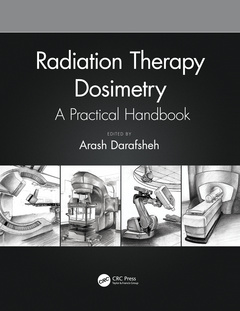Description
Radiation Therapy Dosimetry
A Practical Handbook
Coordinator: Darafsheh Arash
Language: English
Subjects for Radiation Therapy Dosimetry:
Keywords
Ion Chamber; Radiochromic Film; Proton Therapy; Vivo Dosimetry; Small Field Dosimetry; radiation dosimeters; Dose Calculation; radiation measurement; AAPM TG-142; Radiation therapy dosimetry; Bragg Peak; Radiation oncology clinics; FFF Beam; Magnetic resonance imaging; AAPM Task Group; Medical physics; Dose Distribution; Treatment Planning System; EPID; Image Guided Radiation Therapy; Proton Beam; Air Kerma; Reference Dosimetry; Stopping Power Ratio; Field Size; Patient Specific QA; Mu; CBCT; Plane Parallel ICs; Range Verification; PDD
Publication date: 05-2023
· 21.6x28 cm · Paperback
Publication date: 03-2021
· 21.6x28 cm · Hardback
Description
/li>Contents
/li>Biography
/li>
This comprehensive book covers the everyday use and underlying principles of radiation dosimeters used in radiation oncology clinics. It provides an up-to-date reference spanning the full range of current modalities with emphasis on practical know-how. The main audience is medical physicists, radiation oncology physics residents, and medical physics graduate students. The reader gains the necessary tools for determining which detector is best for a given application. Dosimetry of cutting edge techniques from radiosurgery to MRI-guided systems to small fields and proton therapy are all addressed. Main topics include fundamentals of radiation dosimeters, brachytherapy and external beam radiation therapy dosimetry, and dosimetry of imaging modalities. Comprised of 30 chapters authored by leading experts in the medical physics community, the book:
- Covers the basic principles and practical use of radiation dosimeters in radiation oncology clinics across the full range of current modalities.
- Focuses on providing practical guidance for those using these detectors in the clinic.
- Explains which detector is more suitable for a particular application.
- Discusses the state of the art in radiotherapy approaches, from radiosurgery and MR-guided systems to advanced range verification techniques in proton therapy.
- Gives critical comparisons of dosimeters for photon, electron, and proton therapies.
Part I: Radiation Dosimeters and Dosimetry Techniques. Fundamentals of Radiation Physics and Dosimetry. Ionization Chamber Instrumentation. Calorimetry. Semiconductor Dosimeters. Film Dosimetery. Thermoluminescence Dosimetery. Optically Stimulated Luminescent Dosimeters in Clinical Practice. EPID-Based Dosimetry. Scintillation Fiber Optic Dosimetry. Cherenkov and Scintillation Imaging Dosimetry. Clinical Considerations and Dosimeters for In Vivo Dosimetry. Dosimeters and Devices for IMRT QA. Area and Individual Radiation Monitoring. Monte Carlo Techniques in Medical Physics. Part II: Brachytherapy. Brachytherapy Dosimetry. Part III: External Beam Radiation therapy. Photon Beam Dosimetry of Conventional Medical Linear Accelerators. Dosimetric Considerations with Flattening Filter-Free Beams. Linac-Based SRS/SBRT Dosimetry. Cyberknife and Zap-X Dosimetry. Dosimetry in the Presence of Magnetic Fields. Helical Tomotherapy Treatment and Dosimetry. Gamma Knife Dosimetry. Kilovoltage X-Ray Beam Dosimetry. Electron Dosimetry. Proton Therapy Dosimetry. Ion Range and Dose Monitoring with Positron Emission Tomography. Prompt Gamma Detection for Proton Range Verification. Acoustic-Based Proton Range Verification. Proton Radiography and Proton Tomography. Part IV: Imaging modalities. Dosimetry of Imaging Modalities in Radiation Therapy.
Arash Darafsheh, Ph.D., is an associate professor of Radiation Oncology, a certified medical physicist by the American Board of Radiology (ABR), and the PI of the Optical Imaging and Dosimetry Lab at the Department of Radiation Oncology at the Washington University School of Medicine in St. Louis. He holds Ph.D. and M.Sc. in Optical Science and Engineering, and an M.Sc. in Radiation Medicine Engineering. His current research interests include optical methods in medical physics, detector development for radiotherapy, ultra-high dose rate FLASH radiotherapy, photodynamic therapy, and super-resolution microscopy. He has served as a mentor for many graduate students, postdoctoral research fellows, and clinical residents. He has published over 90 journal and conference papers, six book chapters, and one patent. He has been awarded research grants from the National Institutes of Health (NIH) and the American Association of Physicists in Medicine (AAPM). He is a member of AAPM and senior member of the Optical Society of America (OSA) and SPIE-the international society for optics and photonics. He has served as an associate editor for Medical Physics and as a reviewer for numerous scientific journals.




